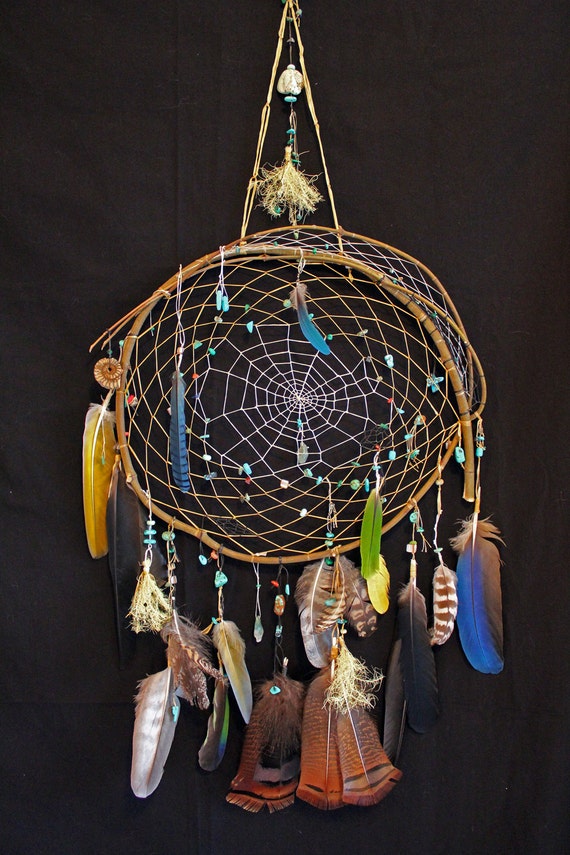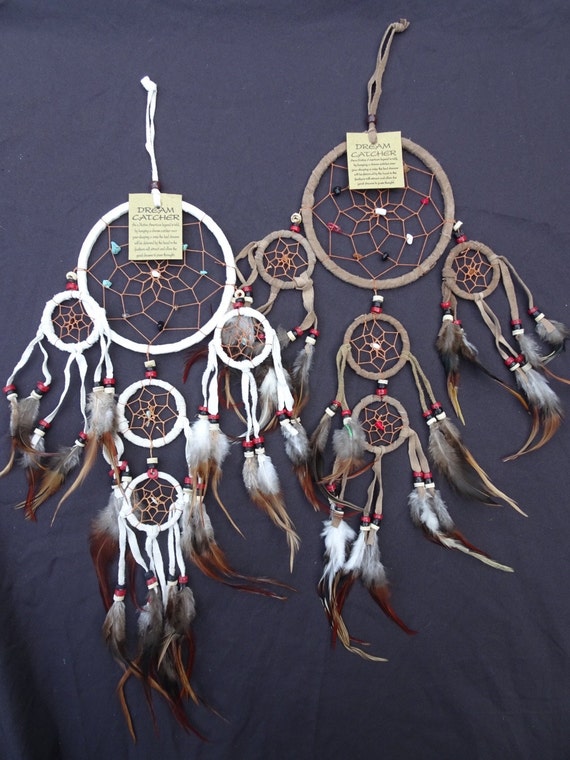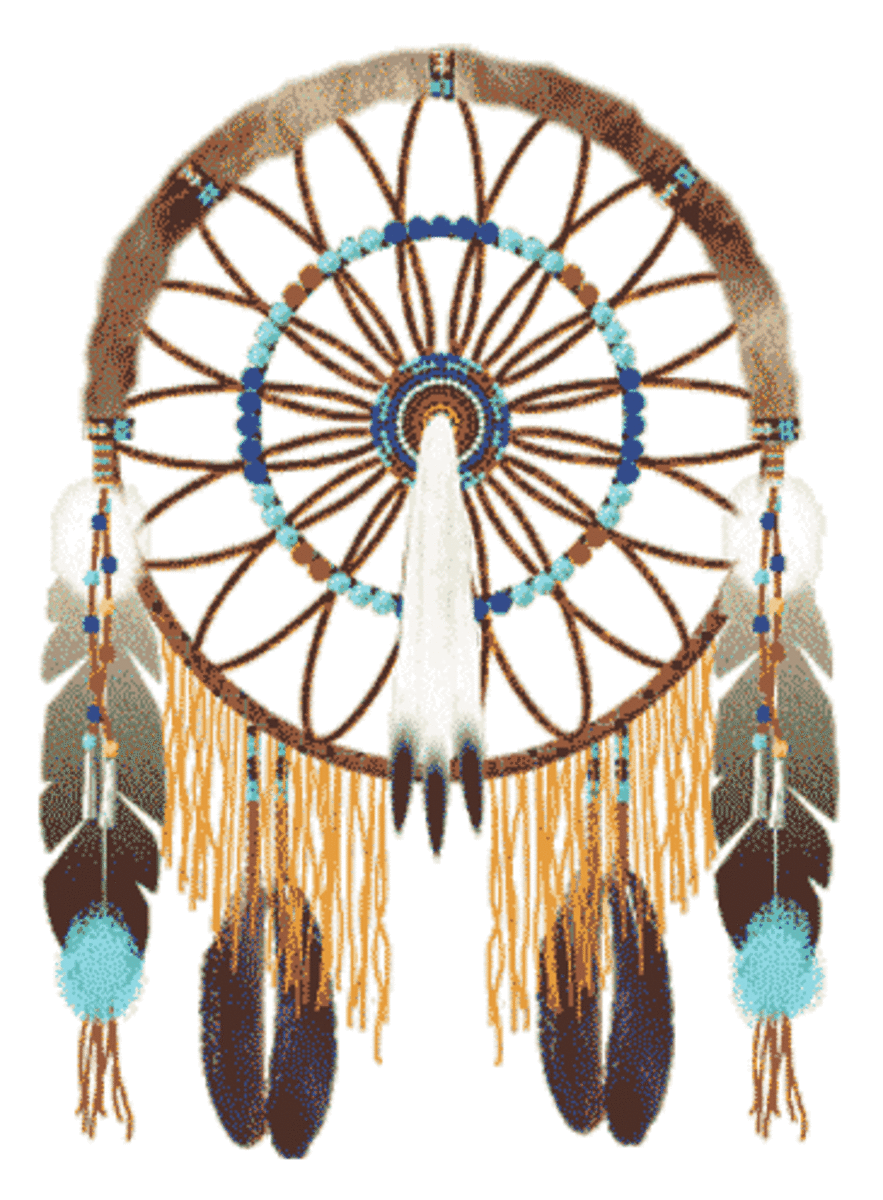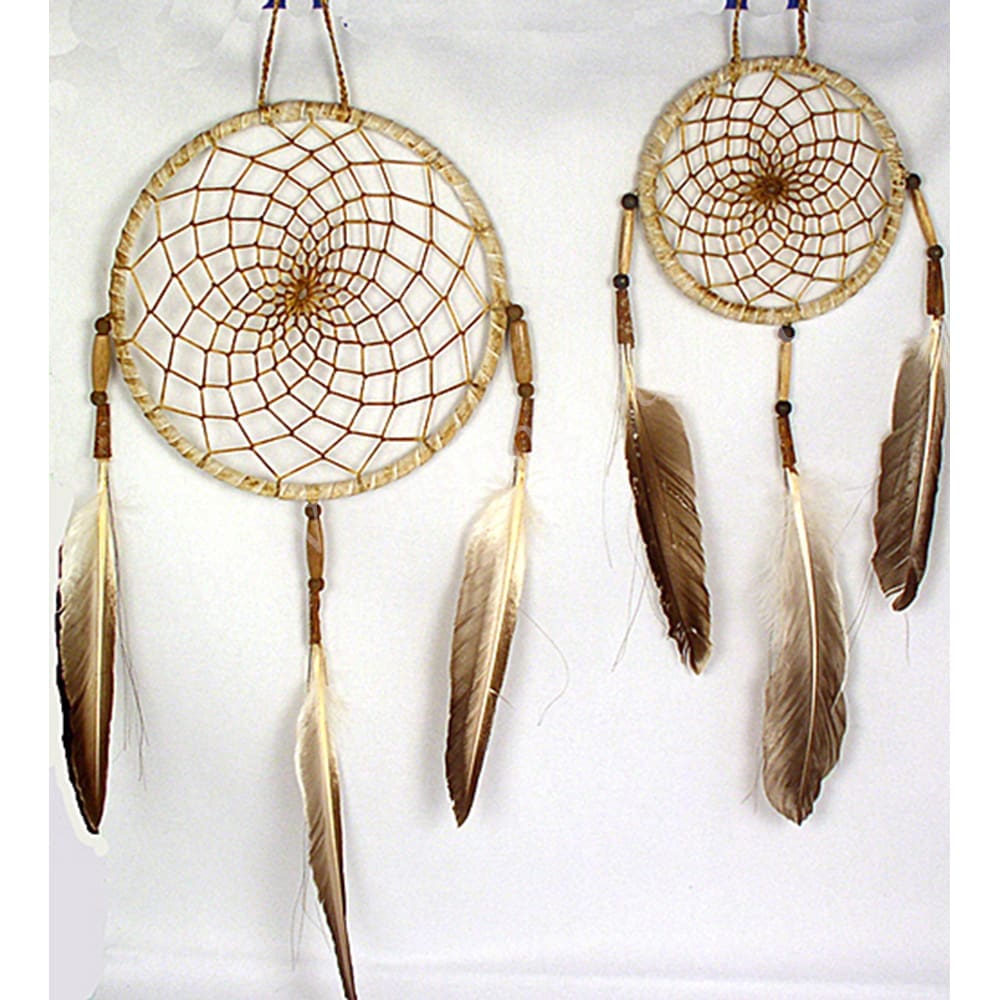
Dream With Color Dream Catcher... Native American Tribal
Native American dream catchers make it easy to decorate with an American Indian theme. The southwestern Indian tribes are still active in making handcrafted artifacts. You can have real antler, leather wood and rawhide. Dream catchers are a great way to dress up a wall in any room.

Dream Catcher Authentic Dream Catcher Native American Etsy
There are many stories behind the meaning and tradition of the dream catcher. The most common meaning of the dream catcher, originating from the Native American Ojibwe tribe, is that it filters the bad dreams away, protecting you from evil and negativity. Traditionally, Native American dream catchers were a few inches in diameter, finished with leather webbing, and a feather hanging from ring.

Traditional Native American Dream Catchers with by AyasArray
149 In many Native American tribes, a dream catcher is a handmade willow hoop woven to a web or literally, a net. They can include feathers and beads, and they're traditionally suspended on cradles as a form of armor and protection. Dream catchers are widely viewed as a symbol of oneness among numerous indigenous cultures and tribes.

dream catchers Dream catcher, Indian dream catcher, Native american decor
Native American dream catchers frequently feature intricate geometric patterns, inspired by the natural world and traditional tribal symbols. Southwestern dream catchers often showcase vibrant colors and bold designs, reflecting the vibrant culture of the region. Boho dream catchers, popular for their eclectic and whimsical style, may.

Native American Indian Dream Catcher
Native American Dreamcatchers & Medicine Wheels At Kachina House we carry a vast selection of Native American dream catchers and medicine wheels, handmade by artists from various tribes. Crafted and accented with natural materials, we offer unique objects of art and craft.

Large Authentic Dream Catcher Ojibwe Native American Above Etsy
The Ojibwe Nation (sometimes spelled Ojibwa) created what is now known as "dream catchers." This tribe is also known as the Chippewa. These hoops entwined with thin rope or netting into a web or "snare" were thought to change the very energy of a room by trapping everything negative within the weaving.

History and Tradition of the Dream Catcher Owlcation
Normally Native American dream catchers are fairly small and are made by bending wood (originally birch) and sinew string tied together. A feather was usually seen hanging from the webbing. Today it is very common to see Native American dream catchers in many places.

Lot Large Native American Style Dream Catcher
Dreamcatchers are an authentic American Indian tradition, from the Ojibway (Chippewa) tribe. Ojibway people would tie sinew strands in a web around a small round or tear-shaped frame--in a somewhat similar pattern to how they tied webbing for their snowshoes--and hang this "dream-catcher" as a charm to protect sleeping children from nightmares.

Native American on horse large dream catcher at www.jkspiritualgifts
Authentic Handcrafted Native American Dream Catchers - DreamCatcher.com. Free Shipping all orders over $60. $5 Flat rate for everything else!! 888-279-0255. Free shipping on orders over $60. $5 Flat Rate shipping Every Day! Made in the USA and Canada by Native Artists! Weekly Deals. Dream Catchers. Fans & Feathers.

Native American style Dreamcatcer Dream catcher Boho Home design Gift
Authentic Dream Catchers Made by Native Americans (1 - 60 of 183 results) Price ($) Shipping Recommended Show Digital Downloads Sort by: Relevancy Dream Catcher made by Native Americans 2"-3" -4" and 6" Dream Catcher Genuine Navajo made dream catchers as close as to original ones. (1.6k) $20.76 $25.95 (20% off)

Luck & Health Dreamcatcher, Copper / Turquoise, Native American
In some Native American and First Nations cultures, a dreamcatcher ( Ojibwe: asabikeshiinh, the inanimate form of the word for 'spider') [1] is a handmade willow hoop, on which is woven a net or web. It may also be decorated with sacred items such as certain feathers or beads.

Dream Catcher Dream catcher native american, Handmade, Native
The dream catcher is a traditional Native American craft. The dream catcher is usually made out of willow hoops and decorated with beads and feathers. The dream catcher is hung over a person's bed and is believed to catch bad dreams and let good dreams through. It is up to you whether or not owning a dreamcatcher is a bad idea, but it is.

Native American dream catcher indian style dream catcher Etsy
The Native Amercan Ojibwa believe that a dreamcatcher filters a person's dreams. According to legend, the good dreams were allowed to filter through, and the bad dreams would stay in the net and disappear with the light of day. Dreamcatchers are hung above someone sleeping to guard against bad dreams. The good dreams pass through and slide down.

Pin by Tomás Hernández. Sánchez on fotos Dream catcher native
The symbolism of a dream catcher is an important part of the Ojibwe culture. The dream catcher is said to protect its owner from bad dreams, nightmares, and evil spirits. The hoop is said to represent the sun and the web is said to represent the moon. The beads and feathers represent the four directions, the colors of the world, and the breath.

Dream Catchers Wandering Bull Native American Shop
The Dreamcatcher Legend. Native Americans of the Great Plains believe the air is filled with both good and bad dreams. According to dreamcatcher legend, the good dreams pass through the center hole to the sleeping person. The bad dreams are trapped in the web where they perish in the light of dawn. How the Dreamcatcher Came to Be

a dream catcher with feathers and beads hanging from it's side on a wall
Today the dreamcatcher is broadly associated with Native American culture in general, but where did the idea originate? Ancient legends about the history of the dream catcher exist today among several Native American tribes, particularly the Ojibwe and Lakota nations.